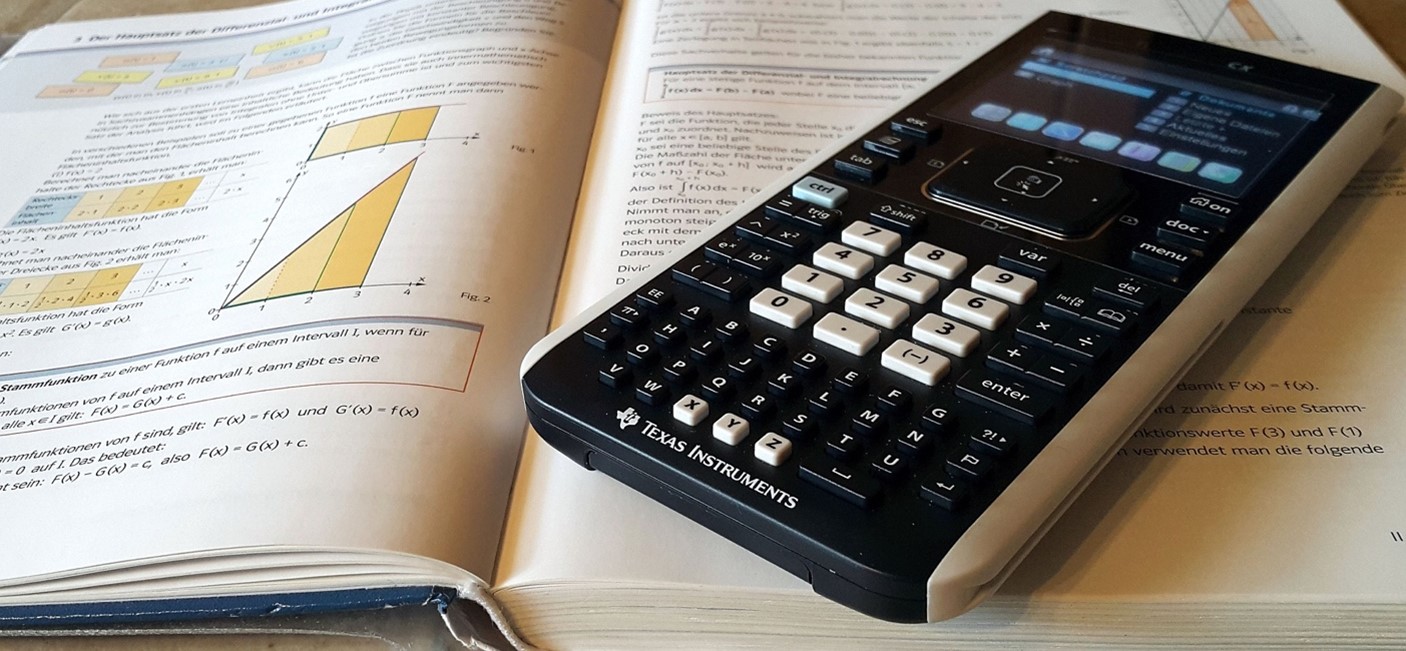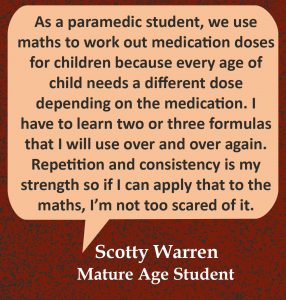2.2: Studying Maths
- Last updated
- Save as PDF
- Page ID
- 146812

- Anita Frederiks & Akshay Sahay
- University of Southern Queensland

Introduction
Mathematics (or maths) is a common part of daily life and forms an important part of our learning journey. In many instances, although we use maths every day, we don’t always recognise it. Likewise, maths may be part of your studies in obvious and subtle ways. This chapter examines approaches to empower you to study maths in whatever form you encounter it at university. It begins by identifying the value of studying maths. It then examines a common problem experienced by students known as maths anxiety and presents six strategies for overcoming it. Next, the chapter addresses how to approach studying maths in general, then how to approach a single module of work in maths, followed by a discussion of problem-solving and hints for success. It concludes with some tips for how to approach maths assessments. Altogether, the chapter will put you on the path to a successful encounter with maths at university.
WHY IS MATHS IMPORTANT?
Maths is an integral part of day-to-day life. We all work with numbers daily, for example, telling time, calculating change when shopping and measuring ingredients when cooking. There are several professions that are highly dependent on maths such as science, engineering and accounting to name a few. Depending on the profession where you are intending to work, the level of maths required will vary. Therefore, the amount of maths that you do will also vary based on your study program. This chapter will help you approach it with a positive attitude and successful strategies to master what is required.
The study of maths is important as it allows you to train your brain to think logically, accurately and carefully helping you to make logical and informed decisions in your life. It also helps you to build confidence to undertake common routine tasks more confidently such as measuring ingredients when cooking and calculating change when shopping.
The study of maths is not about the final answer but the processes and the journey to the final answer. It is about the development of the maths skills needed to perform the required operations that produce the correct answer. These are valuable skills that can be used in future employment.
WHAT IS MATHS ANXIETY AND ITS IMPACT ON THE STUDY OF MATHS?

When it comes to studying maths, students often become anxious and start to overanalyse the maths or statistical content. This then causes an elevated level of anxiety and difficulty in understanding the underpinning concepts. The Australian Council of Educational Research (ACER) defines maths anxiety as “feelings of unease and worry experienced when thinking about mathematics or completing mathematical tasks” (Buckley, Reid, Goos, Lipp, & Thomson, 2016). Maths anxiety is highly prevalent in today’s society. The Australian Mathematical Sciences Institute estimates that between 25% to 80% of the college population in the United States of America has some form of maths anxiety and hypotheses that the percentage is similar in Australia given the similarities in culture (Koch, 2018).
Maths anxiety causes people to have significant self-doubt in their ability to do maths, causing them great distress. When a person has maths anxiety, their brain continually thinks about the anxiety rather than the actual maths problem. This causes the brain to allocate the working memory and other resources that it would normally use with computations of the maths problem to the anxiety itself causing the person not to learn or retain the relevant skills or information (Marshall, Staddon, Wilson, & Mann, 2017).
Symptoms and causes of maths anxiety
Maths anxiety can easily be identified. The symptoms of maths anxiety range from simple low confidence problems to more complex physical symptoms. If you find yourself doing either of the following, you may have maths anxiety:
- If you have low confidence and have negative thoughts such as “I am no good at maths”, “I won’t be able to do this”, “I am never going to understand this maths concept” (Department of Education, Victoria State Government, 2020).
- If you have physical symptoms such as increased heart rate, increased breathing or a panic attack when thinking about or doing maths (Department of Education, Victoria State Government, 2020).
These symptoms are triggered when doing maths or from a thought (anticipation) of doing maths. The level of anxiety will vary from person to person (Department of Education, Victoria State Government, 2020). While maths anxiety is common, it can be managed or resolved allowing you to succeed in your maths learning journey.
Dealing with maths anxiety
Maths anxiety can be addressed in a positive way using six strategies. The strategies will need to be employed over time to see the results. The strategies are also recommended for people without maths anxiety to further develop their maths skills.
Six strategies you can use to help reduce maths anxiety are:
Strategy 1: Creating a safe, calm and comfortable environment in which to study maths: A safe and comfortable environment when studying maths is essential. When you are in a comfortable environment, you have more scope to use your working memory to understand the maths concepts which would otherwise be occupied in a busy or stressful environment.
Strategy 2: Having positive self-efficacy: Self-efficacy is the belief that we are capable of successfully performing a task, for example studying maths. It is critical to change the negative connotations associated with doing maths to positive thoughts. The human mind is probably one of the most powerful objects that can allow you to either excel or limit what you can do. Therefore, if you have maths anxiety, it is important that you change negative thoughts such as “I can’t do this” to “I can do this” or “I am no good at maths” to “I am sure if I try, I can get better at maths”. The self-efficacy that you have is a major factor that influences your confidence. As such, it is paramount that it be addressed from the beginning.
Strategy 3: Practising maths concepts by showing all the processes: Maths is all about using the maths processes. It is important for you to practise the maths concepts with all the processes, showing all your working. When practising the maths concepts with the full working, you are storing the processes in your working memory. This allows you to understand the concept and make a mental map of the concept. It allows your brain to form the connection of where and how to apply the maths concept.
Strategy 4: Seeking help: Asking for help is one of the hardest things that you may have to do. However, for you to succeed with maths (and overcome your maths anxiety if you have it), it is important that you approach your teaching team to seek assistance (or other maths support services which might be available at your university). Your teaching team has extensive experience and knows the concepts in detail. They can help you by breaking down the concepts into smaller and simpler processes that are easier for you to understand. It is also important to remember that you should seek help from the right people to ensure that you are learning the right things.
Strategy 5: Timed practice: It is essential for you to do timed practice of maths concepts and to apply the concepts in all its different forms to ensure that you build your confidence completing maths questions and build your speed in applying the concepts. Timed practice is when you set a timer and work through as many problems as you can in this time. This is modelling what you will need to do during a timed assessment item, such as an exam. During exams and other timed assessment items, the most critical factor is the time you have to complete the questions. To overcome your anxiety of doing maths in timed situations, you need to practice by recreating similar situations.
Strategy 6: Ensuring you understand the process: It cannot be emphasised enough that maths is all about the processes you use to solve problems. It is about training your brain and using your working memory. When you learn and understand the concepts, you make mental mind maps of the concepts, and these are stored in your working memory. This allows for easier recall and application of the process. Memorising or “cramming” does not help you with learning maths effectively, and thus should be avoided.
The use of the six strategies will not only make you more confident but will also help you to form good mental mind maps within your working memory. This will also improve your self-efficacy and break down the barriers that would have otherwise made studying maths more difficult. These strategies can also be used if you don’t have maths anxiety.
FIVE METHODS FOR STUDYING MATHS EFFECTIVELY
Just like the strategies to help reduce maths anxiety, there are methods that can help you study the maths in your courses effectively. These five approaches can equip you for success:
Method 1: Build your skills with practice throughout your course:
Learning maths is like learning a new language. We need to do some practice every day/week. Studying maths concepts shouldn’t be left to just before assignments are due or just before exams. No one becomes good at anything without practice, so regular practice is essential for you to succeed with maths. It is recommended that you practise your maths every day, so that you become familiar with the relevant concepts and skills required to solve the different problems you will see throughout your course. If you need additional strategies to help you with your time management skills, to allow to you practise your maths each day, please see the chapter Time Management. It is also essential to practise concepts from earlier in your course, not just the current module/chapter.
Unfortunately, procrastination and avoiding studying maths is a common experience when you are anxious about maths study. For more information about recognising and developing strategies to combat procrastination, please see the chapter Combatting Procrastination. It is important to master the foundations at the beginning of the course before progressing to the harder material.
It is also vital to show all your working, whenever you are practising maths questions. This allows you to fully practise setting out the steps and processes of the maths concept you are studying. It also allows you to identify any mistakes you may make during the process of answering a question. Practising questions will also help you to recognise similar problems using the same processes.
Method 2: Improve your self-efficacy
Just as it helps you deal with any maths anxiety, improving your self-efficacy around doing maths is important every time you sit down to study maths. If you believe that you can do the maths within your course, you are more likely to spend time working on developing your skills rather than being discouraged and giving up.
Improving your self-efficacy will also motivate you to persevere with questions that you may find difficult, resulting in better marks. If you find yourselves having negative thoughts about our maths ability, try to replace them with positive thoughts. That is, if you find you are thinking “I cannot do this problem”, try instead “I can do similar problems, and with continued practice and seeking help when I need to, I will continue to improve, which will help me to pass this course.”
Method 3: Understanding the process

To be successful in maths, it is necessary to understand the process used for solving maths problems. You are less likely to remember how to do something if you don’t understand the process. If you are shown a calculation in a lecture or tutorial, go over it again later and rewrite it in steps that you understand. Things always look easier when someone else is showing you how to do it, compared to when you try at home on your own. Rewriting the steps will make it easier to complete different questions and you will have good notes for revision. It is also important to remember that there may be more than one method for coming to the right answer. Identify the most appropriate method to complete the question and then apply it. If a question doesn’t specify a particular method to use to solve the problem, you can use a method that suits you best.
As mentioned in the previous section on building your skills through practice, it is essential to show all your working. This allows you to show yourself and others that you understand the processes involved in solving specific problems. It also allows you to go back and follow your thought processes when you need to revise for your exams. Practising your working (with full setting out) will allow you to cement the processes into your working memory. Then things in your setting out will become automatic, for example, aligning your equal signs throughout the problem using the correct symbols and notations, and adding text to explain what you are doing. When these become automatic, you won’t have to worry about them as much in your assessment, as you are doing them all the time.

Method 4: Find techniques that can help you to reduce your stress or maths anxiety
You will need to recognise when you are starting to feel stressed or anxious and having difficulty trying to complete maths problems. You should develop some methods to help you to relax and unwind. Some different strategies you may be able use include distraction techniques including reflecting on how you feel; leaving the room to do another activity for short periods of time; mindful breathing techniques (such as breathing in for a count of 5, holding for a count of 6 and breathing out for a count of 7); or any other techniques you may have for reducing anxiety.
It is also helpful to remind yourself of what you can do by returning to a problem that you can do before attempting the problem which caused the stress. More information about mental health resources (including sections on stress and anxiety) can be found in the chapter Successful Connections.
Method 5: Asking for help

It is essential to recognise when you need help. Asking for help is not the easiest thing to do. However, if you are finding certain concepts difficult, you should ask for help from either your teaching team or other maths support services your university might offer. It is also recommended that you use the online course forums as a medium for asking questions which can be answered by the teaching team or other students. We will give you some more ideas for how to ask for help productively later in the chapter.
APPROACHES FOR STUDYING EACH MODULE
Now that you have some strategies for combatting maths anxiety, and have some general methods for studying maths, you can begin your maths journey at university with a positive mindset. Some degrees will have entire courses that focus on maths, such as Fundamental Statistics, Foundation Mathematics, or Algebra and Calculus. Within these courses, the maths concepts are broken up into smaller segments for you to study, known as modules. Modules allow you to look at one new concept at a time and gradually build your knowledge, experience and confidence. When beginning a new module, try these approaches to make your maths study more manageable:
- Scan the module first to see what it is all about. The objectives in the introduction of the module will also give you a summary of what to expect.
- Start at the beginning of the module, reading through the text and examples. When you come to an activity, attempt the questions yourself. This will help you learn the formulae and when and how to apply them, thus developing your problem-solving techniques. It will also give you an idea of what you know or where you need to focus more.
- Do not skip over pages or chapters in the study materials because maths is a building process that requires the foundations to be strong before you can build upon them.
- Ensure that you have a complete understanding of the topic that you are studying. If you cannot understand a topic, look for alternative resources that may explain it in a different way, contact the teaching team or find a tutor to help. Do this as soon as you have a problem so that you can move on with your studies, and not get behind. Check to see if your university has any maths support services, for example, learning advisors, tutors or peer mentoring programs.
- Summarise the module as you work through it. List any new formulae and problem-solving techniques and take note of anything that you do not understand so you can seek assistance.
- You are encouraged to talk about your maths. It is amazing how problems can be clarified by talking with somebody. You can do this with friends, work colleagues, at our tutorials (in person or online) or through the course discussion forums or groups.
- Contact your teaching team or university maths support (if available) for help if you get stuck. This could save an enormous amount of time, especially when you have any misunderstanding within a topic or module.
STRATEGIES FOR PROBLEM-SOLVING
In many ways, maths is like solving a puzzle, where a question is posed, and you must find the answer. At the heart of this process is what we call problem-solving skills. Problem-solving skills are something that can be practised and developed to make you a stronger mathematician. Most people find problem-solving difficult, and as such, it is an area they need to spend time developing. Problem-solving questions are typically the worded questions you find in the application sections of your materials, or in your assignments. Here are some tips to help develop your skills:
- Read the question or problem carefully and identify what you are expected to find.
- Express the given information in mathematical terms, defining any variables that you are given and noting any special conditions.
- Determine whether any of the information is not needed for solving the problem.
- Break down the problem into smaller parts.
- Estimate the answer to the part of the problem that you cannot solve yet and proceed from there.
- Decide which of the skills or techniques you have learnt in the course that could be applied to solve the problem.
- Apply the technique that you think will solve this problem.
- Check that your answer makes sense to the problem.
Even if things haven’t gone quite right, there are problem-solving strategies you can use to help put yourself back on the right path. You can:
- Check that you copied down everything correctly without error.
- Scan for errors in your calculations.
- Look back at your working and answers to similar questions.
- Start with a fresh page where you cannot see what you have done previously.
- Read the question again slowly.
- Leave the problem for another day.
- Ask for help from your teaching team or maths support services which might be available at your university.
GETTING HELP
Sometimes students need assistance with maths. As discussed, getting help is a successful strategy for fighting maths anxiety and as a problem-solving strategy. Here are some suggestions to maximise the benefits of the help you can get:
- Be specific as to what you don’t understand — you do not want the tutor to cover areas where you do not need help. In other words, being specific about what you need will save you some time in any support sessions you have.
- Attempt to solve the problem(s) yourself first and have your working available so that the tutor can discuss it with you. This will develop your problem-solving skills because you will have thought through the problem and will not be expecting the tutor to do all the thinking for you. It will also show where your understanding is lacking and where you became stuck.
- Attempt similar problems from the study materials or other textbooks/websites that have answers provided, so that you can discuss your problems with the tutor rather than requiring tuition in the basic concepts. This can help tailor the support to your specific needs.
- Be organised and specific. Make a written list of problems that need clarifying, including page numbers in the text, along with your working.
TIPS FOR MATHS ASSESSMENT
After you have studied the modules, you will need to complete some assessment. This section with give you some hints and tips for your assignments and exams.
Maths Assignments

When studying maths, it is essential to develop regular study patterns. Do not leave your maths study until just before an assignment is due. Make sure that you keep up to date with the recommended study schedules provided to you in your courses. This includes working through suggested questions and tutorial questions. Often your tutorial questions will help you to develop the skills needed in your assignments.
When doing a maths assignment, you must express yourself clearly both in English and mathematics. Many students think that doing maths just involves “doing the sums”. However, “doing the sums” is only one part of doing and being involved in maths. In fact, it doesn’t matter how good you are at doing these sums if you cannot communicate your answers or solutions with others. In your career, you must be able to convince your colleagues or clients that your answer is the appropriate one. Therefore, communicating is just as important in maths as it is in all other subject areas.
Finally, you need to also allow adequate time to present your assignment. Just like your other assignments, you need to complete a rough draft and then prepare a final “good” copy. Your makers are looking for assignments that are neat, tidy, with the maths formatted correctly, and with logical, well documented communication (mathematical and English). This could be as simple as following the guides for best practice for maths notation, such as aligning equal signs, centring equations on the page, defining any variables you have used including their units. Your textbooks and study modules are a good guide to how your lecturers are expecting you to format your assignments.
Maths Exams
At the end of your course, you may need to complete an exam. Details about preparing for a maths exam can be found in the chapter Types of Exams. A summary of preparation techniques for maths exams include:
- Review the information about spaced practice in the chapter Preparing for Exams to maximise your exam preparation.
- As you have been practising your maths throughout the course, you won’t need to cram the night before the exam. See additional information on cramming in the chapter Preparing for Exams.
- Review your notes (and worked examples) and make a concise list of key concepts and formulae. Make sure you know these formulae and more importantly, how to use them.
- Work through your tutorial problems again (without looking at the solutions). Don’t just read over them. Working through problems will help you to remember how to do them.
- Work through any practice or past exams which have been provided to you. You can also make your own practice exam by finding problems from your course materials. See the Practice Testing section in the chapter Preparing for Exams for more information.
- When working through practice exams, give yourself a time limit. Don’t use your notes or books. Treat it like the real exam.
- Finally, it is essential to get a good night’s sleep before the exam so you are well rested and can concentrate when you take the exam.
During your exams, you will need to remember your strategies for managing maths anxiety, as this can be heightened during timed exams. You will also need to remember to set out and communicate your maths in a way that the marker can follow. Normally the marker is not looking for perfection, but that you have the correct methods (processes), so communicating what you are doing is just as important or more so than the actual calculations. Practising your setting out throughout all your practice questions, will help you to automatically set out your working.
CONCLUSION
Maths is an integral part of university study, regardless of which course you select. This chapter identified the value of studying maths and provided strategies to help students manage maths anxiety. It also presented methods for approaching studying maths in general, how to study single modules, it discussed problem-solving hints for success and concluded with tips for how to approach maths assessments. Armed with these tips and strategies, you can be ready to learn and work successfully with maths in your university studies.
Key points
- Maths is an important part of the learning journey.
- The study of maths trains your brain to think logically, accurately, and carefully.
- Maths anxiety is something everyone may experience at different stages in their university studies. The six strategies to help you manage it are: Creating a safe, calm and comfortable environment in which to study, developing positive self-efficacy for maths, practising maths (including all working), seeking help when required, timed practice and understanding the process.
- When seeking help, show your tutor your attempt to solve the problem(s) (with your working) so that they can discuss it with you. This will give you the most tailored support.
- Develop your problem-solving skills to help with applying the concepts in different situations, including assessments.
- Present your maths logically with full working and communication in your assignments.
References
Buckley, S., Reid, K., Goos, M., Lipp, O., & Thomson, S. (2016). Understanding and addressing mathematics anxiety using perspectives from education, psychology and neuroscience. Australian Journal of Education, 60(2), 157-170. doi:doi.org/10.1177/0004944116653000
Department of Education, Victoria State Government. (2020, October 27). Mathematics anxiety. Retrieved from State Government of Victoria: www.education.vic.gov.au/sch...csanxiety.aspx
Koch, I. (2018). Mathematics Anxiety Students, Pre- and In-Service Teachers. Melbourne: Australian Mathematical Sciences Institute. Retrieved from amsi.org.au/wp-content/uploa...d_teachers.pdf
Marshall, E., Staddon, R., Wilson, D., & Mann, V. (2017). Addressing mathematics anxiety and engaging students with mathematics within the curriculum. MSOR Connections, 15(3), 28-35. doi:https://doi.org/10.21100/msor.v15i3.555

